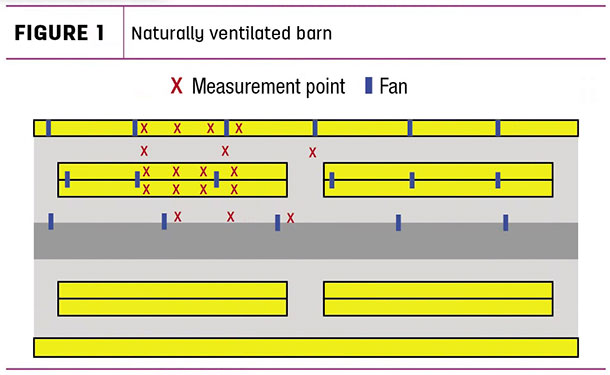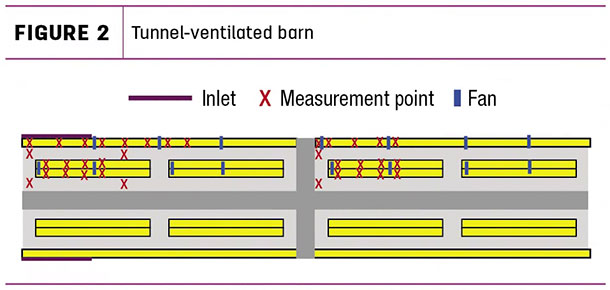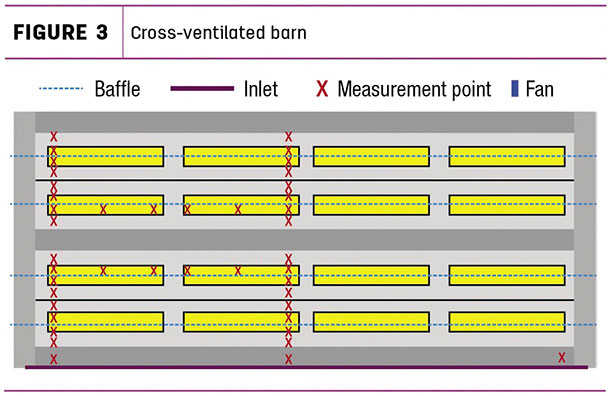While the swine and poultry industry have gravitated toward more uniform systems of ventilation, the dairy industry continues to rely on a variety of solutions that involve natural or mechanical ventilation principles. Nowadays, even naturally ventilated barns employ circulation fans to move air around the cows, and mechanical systems may use positive pressure or negative pressure with tunnel- or cross-ventilation air flow patterns to direct the air parallel or perpendicular to the feedlanes.
All of this industry variation begs the question: “How do we know the ventilation system works?” Everyone has their favorite system, but it would be nice to create criteria to fully and consistently evaluate them, so that is what we have been working on at The Dairyland Initiative for the last few years.
Rather than come to the conclusion that one type of ventilation system is the best, we quickly realized that different systems have pros and cons – and some are better suited to certain climates than others. So we have come up with some basic design criteria to adhere to for any ventilation system. The criteria are:
1. Provide target air speed in the cow’s resting area microenvironment
We need to provide fast-moving air in the resting area in the summer and gentle air movement in the winter. High-producing dairy cattle are susceptible to heat stress in hot conditions and accumulate heat when they rest. If we are to keep cows comfortable and lying down under these conditions, we need to provide a minimum cooling air speed (MCAS) in the lying area at cow resting height to maintain a favorable thermal gradient for heat loss. The available evidence suggests that the MCAS be 200 to 400 feet per minute (2.3 to 4.6 mph). This air speed may be achieved passively through inlet location or baffle placement, or actively through the use of fans or positive-pressure tube delivery systems.
2. Exhaust the heat, moisture, dust and noxious gases from the barn at an adequate rate year-round
Ventilation is the provision of fresh air into the building space, which displaces contaminated, warm, humid air and noxious gases, such as ammonia. If we do not effectively exhaust this air, then the cattle will be at risk for heat stress (summer/hot climate) and poor respiratory health (winter/cold climate). In the winter, we recommend ventilation rates of four to eight air changes per hour (ACH). In the summer, for adult cattle, we typically provide 40 to 60 ACH and a minimum of 1,500 cubic feet per minute (CFM) per adult cow in the barn.
3. Ensure the system works well across all seasons
Too often, the design of the ventilation system is effective for one season (most commonly the summer), but it fails in the winter when the air exchange rate is reduced. It is important to design a system from the start that can function equally well at low and high ventilation rates. Obviously, in climates that are hot year-round, the deficiencies of a system that behaves poorly at low ventilation rates become unimportant – meaning certain types of systems can be favored over another depending on climatic conditions.
4. Make sure the system is cost-effective
An effective ventilation system works to reduce the risk for pneumonia in the winter and the economic losses from heat stress in the summer; those losses accrue from decreased milk production, ill health and effects on the calf in utero and later in life. Unfortunately, economic assessments of those losses are not well documented, but attempts have been made historically to estimate production losses due to heat stress in the U.S. (St. Pierre). We have developed a method to estimate the costs of running a ventilation system in different regions based on climate data and can compare these costs to the estimated regional losses from heat stress. As a rule of thumb, if the running costs of the system are greater than the estimated heat stress losses, we question the economic viability of the system.
To evaluate ventilation, we need some important tools: a laser tape measure (to measure the barn dimensions), devices to measure temperature and humidity inside the barn, an anemometer (to measure air speed) and a differential pressure meter (to measure the pressure difference between the inside and the outside of the barn). There are multiple devices that can be used, but we favor the ease of use and practicality of many of the options available from Kestrel Instruments at kestrelinstruments.com/agriculture.
The key measurements we assess in mechanically ventilated barns are:
- Determine the maximum and minimum air changes per hour based on an estimate of the fan exhaust capacity (as rated by the manufacturer or an independent source such as Bess Lab at the University of Illinois at bess.illinois.edu/index2.htm). Ensure at least 4 ACH in the winter and 40 ACH in the summer as a rule of thumb.
- Determine the fan exhaust capacity per animal housed in the barn. Ensure at least 1,500 CFM per adult cow.
- Determine the maximum increase in temperature between the inlet side of the barn and the outlet side of the barn, preferably during periods of heat stress. (Maximum allowable increase in temperature is recommended to be less than 3.8ºF.)
- Determine the pressure differential between the inside and the outside of the barn to ensure the fans chosen can operate under the negative pressure (in H2O) measured.
- Determine the inlet air speed to ensure air is entering at a speed for adequate mixing with the air within the barn but not so fast that it may impede the flow of air toward the fans. (Typically, we aim for 500 to 800 feet per minute.)
Ensure that 80% or more of the resting areas within mechanically and naturally ventilated barns receive resting height air speeds of 200 to 400 feet per minute using a technique we call “air speed mapping.”
For air speed mapping, we mount two anemometers on a tripod at heights of roughly 5 feet and 1.5 feet to measure standing and resting height air speeds respectively. We then move the device around the barn and measure air speed at multiple locations, chosen based on barn type.
For naturally ventilated barns, the focus is on charting the air speed pattern in stalls between fans to determine if the fans are adequately spaced. It is OK to take air speed measurements in a representative section of the stalls.

For tunnel-ventilated barns, we assume that the pens are mirrored on either side of the center feedlane, and we again focus on the air speed in the stall beds, with particular attention around the circulation fans, inlets and after any barn connectors.

For cross-ventilated barns, we assume that the pens are mirrored either side of their midpoint along the side wall inlet and take measurements in an H shape in stalls and alleys before and after baffles.

With these measurements, we can perform a critical assessment of any ventilation system and determine whether or not it meets our design criteria. To learn more, we regularly hold workshops to help train attendees on the approach – so look out for future trainings on our website and access more information on ventilation and cooling at the Dairyland initiative ![]()
Nigel Cook is currently chair of the Department of Medical Sciences at the University of Wisconsin – Madison School of Veterinary Medicine and manages the Dairyland Initiative.

-
Nigel B. Cook
- Veterinarian
- UW – Madison, School of Veterinary Medicine








